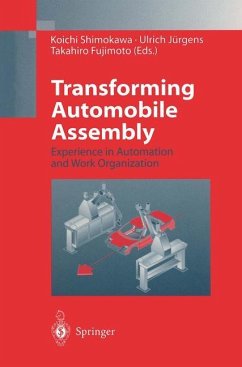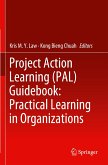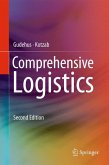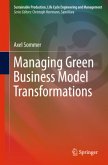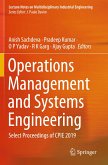Transforming Automobile Assembly
Experience in Automation and Work Organization
Herausgegeben:Shimokawa, Koichi; Jürgens, Ulrich; Fujimoto, Takahiro
Transforming Automobile Assembly
Experience in Automation and Work Organization
Herausgegeben:Shimokawa, Koichi; Jürgens, Ulrich; Fujimoto, Takahiro
- Broschiertes Buch
- Merkliste
- Auf die Merkliste
- Bewerten Bewerten
- Teilen
- Produkt teilen
- Produkterinnerung
- Produkterinnerung
Five years after the publication of MITs lean production book practitioners and academics from Japan, USA and Europe present new concepts, findings and conclusions in regard to one of the most critical areas of automobile production. The focus of the book is to explore automation and work organization for the final assembly operations in the world automobile industry. The authors are company practitioners in charge of planning assembly operations and academic researchers drawing from recent empirical work. Thus, the book presents a multi-facetted view on a development of critical importance…mehr
Andere Kunden interessierten sich auch für
![Management of Uncertainty Management of Uncertainty]() Gudela GroteManagement of Uncertainty75,99 €
Gudela GroteManagement of Uncertainty75,99 €![Management of Uncertainty Management of Uncertainty]() Gudela GroteManagement of Uncertainty75,99 €
Gudela GroteManagement of Uncertainty75,99 €![Project Action Learning (PAL) Guidebook: Practical Learning in Organizations Project Action Learning (PAL) Guidebook: Practical Learning in Organizations]() Project Action Learning (PAL) Guidebook: Practical Learning in Organizations75,99 €
Project Action Learning (PAL) Guidebook: Practical Learning in Organizations75,99 €![Project Action Learning (PAL) Guidebook: Practical Learning in Organizations Project Action Learning (PAL) Guidebook: Practical Learning in Organizations]() Project Action Learning (PAL) Guidebook: Practical Learning in Organizations75,99 €
Project Action Learning (PAL) Guidebook: Practical Learning in Organizations75,99 €![Comprehensive Logistics Comprehensive Logistics]() Timm GudehusComprehensive Logistics150,99 €
Timm GudehusComprehensive Logistics150,99 €![Managing Green Business Model Transformations Managing Green Business Model Transformations]() Axel SommerManaging Green Business Model Transformations112,99 €
Axel SommerManaging Green Business Model Transformations112,99 €![Operations Management and Systems Engineering Operations Management and Systems Engineering]() Operations Management and Systems Engineering171,99 €
Operations Management and Systems Engineering171,99 €-
-
-
Five years after the publication of MITs lean production book practitioners and academics from Japan, USA and Europe present new concepts, findings and conclusions in regard to one of the most critical areas of automobile production. The focus of the book is to explore automation and work organization for the final assembly operations in the world automobile industry. The authors are company practitioners in charge of planning assembly operations and academic researchers drawing from recent empirical work. Thus, the book presents a multi-facetted view on a development of critical importance for future development of the industry. The book is rich with figures, fotos, tables, thus making the text vivid, easy to understand and illustrative.
Produktdetails
- Produktdetails
- Verlag: Springer / Springer Berlin Heidelberg / Springer, Berlin
- Artikelnr. des Verlages: 978-3-642-64377-4
- Softcover reprint of the original 1st ed. 1997
- Seitenzahl: 428
- Erscheinungstermin: 22. September 2011
- Englisch
- Abmessung: 235mm x 155mm x 24mm
- Gewicht: 644g
- ISBN-13: 9783642643774
- ISBN-10: 3642643779
- Artikelnr.: 36115846
- Herstellerkennzeichnung Die Herstellerinformationen sind derzeit nicht verfügbar.
- Verlag: Springer / Springer Berlin Heidelberg / Springer, Berlin
- Artikelnr. des Verlages: 978-3-642-64377-4
- Softcover reprint of the original 1st ed. 1997
- Seitenzahl: 428
- Erscheinungstermin: 22. September 2011
- Englisch
- Abmessung: 235mm x 155mm x 24mm
- Gewicht: 644g
- ISBN-13: 9783642643774
- ISBN-10: 3642643779
- Artikelnr.: 36115846
- Herstellerkennzeichnung Die Herstellerinformationen sind derzeit nicht verfügbar.
Five years after the MIT-Report on the situation in worlds automotive industries the results of the changes in work organization and automation are reviewed and evaluated. Experts from Japan, Europe and US America join their skills in this publication. The reader will get an inside-view into all leading car-making companies.
1 Introduction.- 1 Introduction.- 2 Concepts and Histories.- 2.1 Assembly Automation in Europe - Past Experience and Future Trends.- 2.2 Basic Trends in the Physics and Economics of Automated Fabrication and Assembly Operations.- 2.3 Key Characteristics of Assembly Automation Systems.- 2.4 What Do You Mean by Automation Ratio? Definitions by the Japanese Auto Makers.- 3 Diversity of Approaches.- 3.1 Present State and Future Vision of Vehicle Assembly Automation in Mitsubishi Motors Corporation.- 3.2 Development of a new Vehicle Assembly Line at Toyota: Worker-oriented, Autonomous, new Assembly System.- 3.3 Modular Assembly in Mixed-Model Production at Mazda.- 3.4 Production of the NSX at Honda: An Alternative Directionfor Assembly Organization.- 3.5 The Development of an Intelligent Body Assembly System.- 3.6 The Opel Production System.- 3.7 Platform and Modular Concepts at Volkswagen - Their Effects on the Assembly Process.- 3.8 Automation at Renault: Strategy and Form.- 3.9 Building Capabilities in Assembly Automation: Fiat's Experiences from Robogate to the Melfi Plant.- 3.10 The Development of a Reflective Production System Layout at Volvo's Uddevalla Car Assembly Plant.- 4 Issues and Dynamics.- 4.1 Strategies for Assembly Automation in the Automobile Industry.- 4.2 From Fixed to Flexible: Automation and Work Organization Trends from the International Assembly Plant Study.- 4.3 Rolling Back Cycle Times: The Renaissance of the Classic Assembly Line in Final Assembly.- 4.4 Rationalization also Involves Workers - Teamwork in the Mercedes-Benz Lean Concept.- 4.5 Patterns of Work Organization in the German Automobile Industry.- 4.6 The Current Social Form of Automation and a Conceivable Alternative: Experience in France.- 4.7 Worker-Generated ProductionImprovements in a Reflective Production System - or Kaizen in a Reflective Production System.- 4.8 Advanced Automation or Alternative Production Design? A Reflection on the new Japanese Assembly Plants and the Alternative Approach of Volvo Uddevalla.- 4.9 A Misguided Trajectory? Automatically Guided Vehicles in Auto Assembly.- 4.10 Organizational Change and Assembly Automation in the Dutch Automotive Industry.- 4.11 Recycling and Disassembly - Legal Burden or Strategic Opportunity?.- 5 Conclusions and Outlook.- 5.1 Lessons to be Learnt from the Japanese Style of Production and their Application to Factory Automation.- 5.2 Design Choices for Assembly Systems.- 5.3 Outlook.- 6 The Authors of the Book.
1 Introduction.- 1 Introduction.- 2 Concepts and Histories.- 2.1 Assembly Automation in Europe - Past Experience and Future Trends.- 2.2 Basic Trends in the Physics and Economics of Automated Fabrication and Assembly Operations.- 2.3 Key Characteristics of Assembly Automation Systems.- 2.4 What Do You Mean by Automation Ratio? Definitions by the Japanese Auto Makers.- 3 Diversity of Approaches.- 3.1 Present State and Future Vision of Vehicle Assembly Automation in Mitsubishi Motors Corporation.- 3.2 Development of a new Vehicle Assembly Line at Toyota: Worker-oriented, Autonomous, new Assembly System.- 3.3 Modular Assembly in Mixed-Model Production at Mazda.- 3.4 Production of the NSX at Honda: An Alternative Directionfor Assembly Organization.- 3.5 The Development of an Intelligent Body Assembly System.- 3.6 The Opel Production System.- 3.7 Platform and Modular Concepts at Volkswagen - Their Effects on the Assembly Process.- 3.8 Automation at Renault: Strategy and Form.- 3.9 Building Capabilities in Assembly Automation: Fiat's Experiences from Robogate to the Melfi Plant.- 3.10 The Development of a Reflective Production System Layout at Volvo's Uddevalla Car Assembly Plant.- 4 Issues and Dynamics.- 4.1 Strategies for Assembly Automation in the Automobile Industry.- 4.2 From Fixed to Flexible: Automation and Work Organization Trends from the International Assembly Plant Study.- 4.3 Rolling Back Cycle Times: The Renaissance of the Classic Assembly Line in Final Assembly.- 4.4 Rationalization also Involves Workers - Teamwork in the Mercedes-Benz Lean Concept.- 4.5 Patterns of Work Organization in the German Automobile Industry.- 4.6 The Current Social Form of Automation and a Conceivable Alternative: Experience in France.- 4.7 Worker-Generated ProductionImprovements in a Reflective Production System - or Kaizen in a Reflective Production System.- 4.8 Advanced Automation or Alternative Production Design? A Reflection on the new Japanese Assembly Plants and the Alternative Approach of Volvo Uddevalla.- 4.9 A Misguided Trajectory? Automatically Guided Vehicles in Auto Assembly.- 4.10 Organizational Change and Assembly Automation in the Dutch Automotive Industry.- 4.11 Recycling and Disassembly - Legal Burden or Strategic Opportunity?.- 5 Conclusions and Outlook.- 5.1 Lessons to be Learnt from the Japanese Style of Production and their Application to Factory Automation.- 5.2 Design Choices for Assembly Systems.- 5.3 Outlook.- 6 The Authors of the Book.

